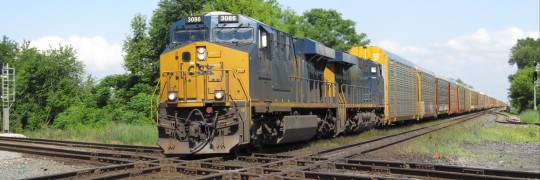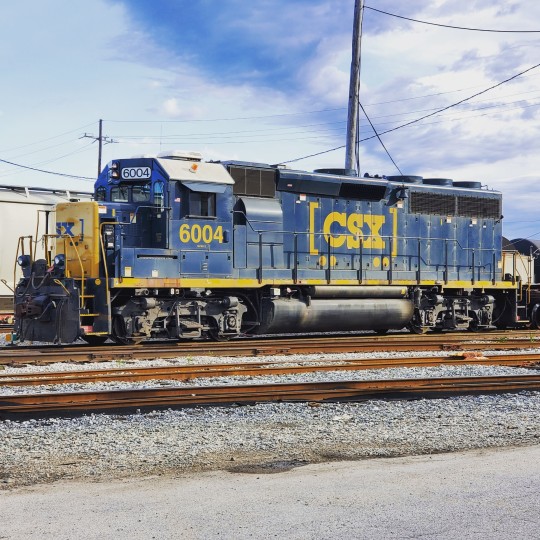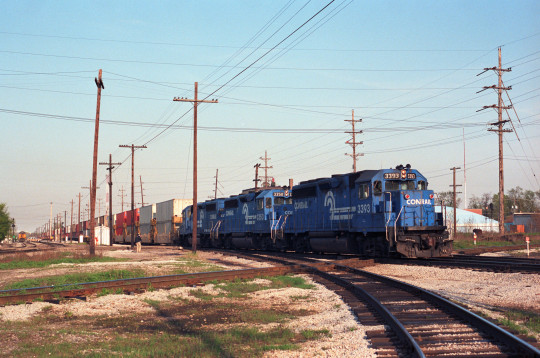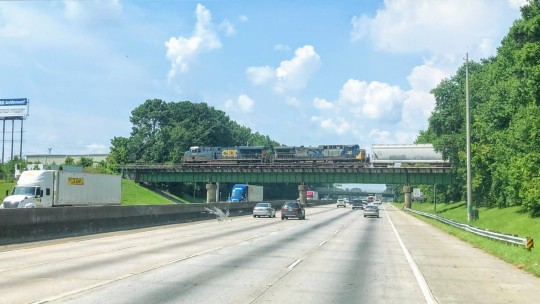#CSXT
Explore tagged Tumblr posts
Text
HOTRAIL PRODUCTIONS


#railroads#trains#locomotives#passenger trains#amtrak#metra#csxt#norfolk southern#shortline railroads#ohio#chicago#youtube#rails#ties#freight cars
11 notes
·
View notes
Text

“Nashville-Bound Manifest”
Heading South through Western Kentucky, CSX ES44AH No. 1869 with ES44AH No. 3074 and AC4400CW No. 270 leads Q589 to Nashville, Tennessee along the Henderson Subdivision.
Models and Route by: Jointed Rail, Auran, and Download Station
#CSX#CSX Transportation#CSXT#CSX Railroad#CSX 1869#C&O Railway#Chesapeake & Ohio#Chesapeake & Ohio Railway#ES44AH#GE ES44AH#GEVO#GE Evolution Series#GE GEVO#GE#General Electric#Heritage Unit#AC4400CW#AC44CW#Diesel Locomotives#Trains#Trainz Simulator
1 note
·
View note
Text
Lessons for Nationalization:
Mergers
A thing I've learned reading about the railroads is there's a good and bad way to go about merging a company. The good way is planned, gradual, and thought out to the circumstances of the companies. The foremost example would be the "affiliation" and merger of the B&O and C&O RRs into the Chessie System over 10 years from 1963-73. Another good example is the slow merger of Chessie and the Seaboard System into CSX that took place from 1980 to 1987.


Conversely what not to do is illustrated by the Infamous merger of the Penn Central. Before merging the Pennsylvania and New York Central Railroads were well established but struggling. However after the companies joined together there would be an exodus of former NYC managers and personnel, with PRR employees clamoring to fill the empty positions. The new management that was unacquainted with the operations and circumstances of the NYC subdivisions would be one of the factors that set PC down the path of financial ruin. The decay of Penn Central would require the creation of Conrail in 1976 to prevent the destruction of rail completely in the Northeast.


What the Sucess of Chessie/CSX and the abject failure of PC can tell us is merging railroads is not something to be done without careful planning and knowledge of the complex functions and dynamics of both organizations. Nationalization of the class I Companies would require the input of Railworkers, Shippers, and Insiders with intimate knowledge of company affairs to keep a continuity of service and ensure a smooth, well organized transition from private to public ownership. Only with such knowhow, forethought, and measured action would a national carrier be able to avoid the mistakes that destroyed Penn Central and preserve the networks of the pre merger companies.
#csxt#chessie system#Seaboard System#c&o railway#B&O railroad#PRR#NYC#Penn Central#railfanning#railroad#business#finance#organization#management#nationalization#organizational culture#organizationaldevelopment#organizational studies#policy#us politics#conrail#mass transit#transportation#progressivism
0 notes
Text

Conrail - Dolton, IL
A trio of Conrail GP40-2s lead a westbound double-stack on the Harbor at Dolton, while a westbound CSXT train awaits a signal on the Barr Sub, in May 1987.
62 notes
·
View notes
Video
Waiting At 150 por David Blazejewski Por Flickr: Love the return of these beautiful colors so here's another from this lucky impromptu catch when I just happened to be nearby for non train reasons. Housatonic Railroad train NX12 is nearing the end of their 38 mile trip up from Canaan, Connecticut with outbound cars for the CSXT interchange. The have pulled up just shy of CP150 on CSXT's Berkshire Sub and are waiting for a recrew before pulling out on to the old Boston and Albany main and east through downtown to Pittsfield yard where they will drop their train and pick up inbound interchange to take back south. The train is at stretched across the bridge over the West Branch of its namesake river here at about MP 85.9 on the HRRC's Berkshire Line main being led for the first time by all three of the road's sharply painted GP15-1s, which only arrived on the property in January of this year. All are former Missouri Pacific units originally delivered in MoPac dark blue that later wore UP Armour yellow before being sold to broker/rebuilder Metro East Industries in the St. Louis area. HRRC 1512, 1510, and 1511 are ex UPY 704, 622, and 662 and were built as MP 1704, 1622 and 1662 in Apr. 1982, Sep. 1979 and Aug. 1980 respectively. Pittsfield, Massachusetts Sunday April 13, 2025
2 notes
·
View notes
Text
there's someone in the us around georgia painting CSX locomotives with heritage paint schemes (railroads that were absorbed/bought) and I think it is in fact funny, they look to know what they are doing even taking the care to mask important markings, their paintwork almost looks like it came from the paintshop, not something done under the cover of dark in a night.

CSX 6914 wearing chessie system scheme "graffitti"
RailPictures.Net Photo: CSXT 6914 CSX Transportation (CSXT) EMD GP40-2 at Cartersville, Georgia by Casey Thomason
2 notes
·
View notes
Text
Tampa Port Rail Spur Gets $900M, Industrial Land Soars

900 Million Investment Transforms Tampa's Rail Infrastructure LandscapeNearly $40 million in strategic infrastructure investments is reshaping Tampa's maritime rail environment. Port authorities are racing to capture surging containerized freight volumes.The massive capital deployment centers on two critical rail improvements. These upgrades are designed to accelerate cargo throughput at Florida's busiest container terminals.Port Tampa Bay secured over $19.8 million in infrastructure funding. This will expand capacity at the Hooker's Point container facility.Port Manatee received $19.2 million for supply chain efficiency enhancements. These parallel investments target the region's freight rail bottlenecks, which have constrained trade growth for years.The infrastructure funding package includes realignment of the rail spur at Hooker's Point. It also features upgrades to the CSX/Seminole Gulf Railway freight corridor under long-range development plans.Rail improvements also encompass grade separation of Causeway Boulevard and the Rockport Lead track. These address critical chokepoints in Tampa's expanding intermodal network.The CSXT Tampa Terminal currently handles 28 daily trains serving Phosphate Pier facilities. This demonstrates existing capacity constraints driving the urgent modernization push. The funding awards follow competitive evaluation of 173 applications requesting approximately $7.4 billion nationwide.Industrial Land Values Surge Amid Enhanced Port ConnectivityDramatic infrastructure investments are impacting Tampa's port-connected zones.Industrial land values are experiencing unprecedented acceleration. West Downtown St. Louis is witnessing a similar rise in interest and investment due to its strategic urban planning efforts.Industrial rental rates have hit a record-breaking $12.50 per square foot. This marks a staggering 69.1% increase over five years.Property sales now average $140 per square foot. In the past year, total sales volume reached $895 million.This escalation surpasses the national average of $129 per square foot. The national rate itself represents a 62% rise since 2019.Port Tampa Bay's improved deep-water access boosts industrial demand. Integrated rail connectivity enhances logistical advantages.The port boasts 1,000 acres of industrially zoned land. It offers 43-foot deep-water channels with extensive rail service.Zoning regulations for Free Trade Zone parcels offer economic incentives. These incentives encourage further industrial development.Despite a 6.3% vacancy rate increase, market fundamentals remain strong. Leasing activity has exceeded 10 million square feet for the fifth consecutive year. Continued infrastructure investments are reshaping Tampa's industrial landscape.Economic Impact and Job Creation Opportunities Across the RegionEconomic transformation is sweeping through West Central Florida, with Port Tampa Bay establishing itself as a $34.6 billion economic powerhouse. The port's significant infrastructure investments are fueling unprecedented job growth across multiple sectors, supporting over 192,000 regional positions.Maritime-related jobs offer premium wages, averaging $74,350 annually, which is substantially higher than regional averages. Direct business activities at the port generate $4.6 billion, and re-spending and consumption add another $2.8 billion in economic benefits.User-related activities contribute a staggering $27.2 billion to the regional economy. This illustrates the port's extensive impact beyond traditional maritime operations. Job creation spans direct, indirect, induced, and related positions across diverse industries.Strategic infrastructure investments, such as enhancements to the rail spur, are positioning the region for accelerated economic expansion. The port's role as a top-10 U.S. cruise destination and major shipbuilding center further broadens employment opportunities.State and local tax revenues are rising, alongside personal earnings growth. This
establishes West Central Florida as a formidable economic corridor with sustained growth potential. Meanwhile, similar to Miami industrial markets, the demand for industrial land in West Central Florida is surging, driven by the scarcity of land and robust economic activities.Future Expansion Plans and Strategic Development InitiativesPort Tampa Bay is building on its economic momentum with an aggressive expansion blueprint that aims to reshape Florida's freight transportation over the next decade.The centerpiece of this plan is the $37 million East Port Omniport facility expansion, backed by $22 million in federal grants. This project is focused on enhancing supply chain optimization capabilities.Strategic partnerships with CSX are also in play, accelerating the Tampa Gateway Rail project. This initiative is designed to revolutionize unit train operations and improve transportation efficiency across the region.InitiativeInvestmentTimelineEast Port Expansion$37MCurrentGateway Rail ProjectTBD2024-2026CSX Corridor UpgradesRegionalMulti-yearInland Port DevelopmentPrivate SectorOngoingPort officials are actively pursuing land acquisition strategies to support expanded industrial operations. Multimodal freight capabilities will increase significantly through coordinated rail and port infrastructure improvements.The strategic development framework emphasizes sustainability initiatives. It also seeks to maximize operational capacity for larger vessels and enhanced logistics networks.AssessmentThe $900 million rail infrastructure investment has fundamentally altered Tampa's industrial real estate dynamics. This shift has created unprecedented value changes across the region.Property values near the enhanced port connectivity have experienced dramatic appreciation. This signals a new era of industrial development in Tampa.The transformation positions Tampa as a critical logistics hub. These changes have far-reaching implications for freight transportation and commercial real estate markets throughout Florida's west coast corridor.
0 notes
Text

HMCR U23B 9554
Huntsville & Madison County Railroad ( HMCR ) Freight awaits a fresh crew at Huntsville, AL. with U23B 9554 in charge, the 9554 is former CSXT U23B 3301 & started as L&N U23B 2800.
Lawrence the U23B
0 notes
Text
0 notes
Text
Introduction Model rocket flight is a thrilling and exciting experience. These rocket models, although small in size, can soar to impressive heights. Launching a rocket model is a popular hobby among science enthusiasts and young children who want to learn about the principles of physics, energy, and motion. The history of model rocketry dates back to 1954, when Orville Carlisle and G. Harry Stine, who are well-known pioneers of model rocketry, formed the National Association of Rocketry. Since then, model rocketry has been gaining popularity, and several people have built and launched models that have set impressive records. In this article, we will discuss the highest model rocket flight and the factors that determine the height of a rocket. We will also provide insights into the construction of a model rocket and the necessary safety measures to take when launching one. Highest Model Rocket Flight The highest model rocket flight ever recorded was attained by a rocket built by the Civilian Space eXploration Team (CSXT) on May 17, 2004. This rocket, named GoFast, reached an altitude of 72 miles or 366,576 feet, which is equivalent to 111.98 km. The launch took place in Nevada's Black Rock Desert, and the rocket was recovered a few hours later. GoFast was constructed with the standard components used in model rocketry: a motor, parachute, and nose cone. However, unlike traditional model rockets, GoFast was designed to replicate a sounding rocket, which is an instrument-carrying rocket used to study the Earth's upper atmosphere and beyond. To achieve the impressive height, the rocket was launched using a cluster of four hybrid rocket motors. A hybrid rocket motor uses both a solid propellant and a liquid or gaseous oxidizer to combust, creating a high thrust level that propels the rocket forward. The hybrid rocket motor used in this rocket was designed and built by CSXT. The GoFast rocket's ascent was tracked and guided by an onboard GPS system, which collected and transmitted data throughout the flight. The rocket reached its highest altitude after 106 seconds, and the parachute system was deployed, allowing the rocket to descend back to Earth. Factors that Determine the highest model rocket flight Several factors determine the height that a model rocket can reach. The fundamental factor is the rocket's weight, which is the force of gravity acting on the rocket. As a result, a lighter rocket will ascend higher than a heavier one. Another factor is the rocket's aerodynamic design. A well-designed rocket will reduce drag and air resistance, increasing the rocket's speed and height. This is achieved through the shape of the body, fins, and nose cone. The rocket's motor also plays a crucial role in determining the height reached. A higher thrust motor will propel the rocket to a greater height, and the duration of the motor's burn time will determine how long the rocket will ascend before reaching its highest altitude. A motor with a longer burn time will achieve greater height and provide enough time to deploy the parachute. Finally, weather and wind conditions can affect a rocket's height. Launching a rocket on a calm day with no wind will allow the rocket to ascend straight up without being blown off course, leading to an increased height. Construction of a Model Rocket Model rockets are constructed with specific components that are designed to meet certain specifications. The critical components include the body tube, nosecone, fins, motor, and parachute. The body tube is the main structure of the rocket, usually made from paper or plastic. It houses the motor, and other components are attached to it. The nose cone is designed to streamline the rocket and is usually made from plastic or balsa wood. The fins are attached to the bottom of the rocket and help stabilize it during flight. The motor is responsible for creating the thrust that propels the rocket into the air. Model rocket motors are classified based on their total impulse, which is the amount of energy that the motor produces.
The amount of energy produced determines the rocket's thrust, speed, and height. The parachute is deployed after the rocket has reached its highest altitude, allowing it to descend to Earth safely. It is essential to ensure that the parachute system is well designed to prevent the rocket from hitting the ground too hard, which can damage the rocket or cause injury to anyone nearby. Safety Measures when Launching a Model Rocket Launching a model rocket can be a hazardous activity if safety measures are not taken into consideration. Some of the safety measures when launching a model rocket include: 1. Choosing the right launch site - ensure that the launch site is free from any obstructions such as trees, electrical poles, or buildings. 2. Clear the area around the launch site - ensure that the area is clear of any individuals, animals or vehicles. 3. Wear protective gear - safety glasses and gloves should be worn when handling the model rocket and the launch equipment. 4. Follow manufacturer's guidelines - ensure that the model rocket is constructed according to the manufacturer's guidelines. Conclusion of highest model rocket flight Model rocketry is a fun and educational activity that can provide valuable insights into the principles of physics and energy. The highest model rocket flight ever recorded demonstrates the potential heights that can be achieved with the right components, design, and launch conditions. When launching a model rocket, it is essential to take the necessary safety precautions to prevent accidents and ensure a successful launch. FAQs Q1. How high can a model rocket fly? A: The height to which a model rocket can fly depends on several factors, including the rocket's weight, design, motor, and launch conditions. With the right components and conditions, a model rocket can reach heights of several thousand feet. Q2. Is rocketry safe? A: Model rocketry can be safe if the proper safety measures are taken into consideration. Safety glasses and gloves should be worn when handling the model rocket and the launch equipment, and the launch site should be free from any obstructions and individuals. Q3. What is a hybrid rocket motor? A: A hybrid rocket motor uses both a solid propellant and a liquid or gaseous oxidizer to combust, creating a high thrust level that propels the rocket forward. Q4. What are the components of a model rocket? A: The critical components of a model rocket include the body tube, nosecone, fins, motor, and parachute. Q5. Can anyone launch a model rocket? A: Yes, anyone can launch a model rocket as long as the necessary safety measures are taken into consideration. It is also essential to follow the manufacturer's guidelines when constructing and launching the model rocket. If you have any questions or comments Please contact us on our contact page or via our Facebook page. #highest #model #rocket #flight
0 notes
Text
youtube



#csx#csxt#csx corp#youtube#youtube video#yt#video#train#trains#intermodal#intermodal train#rr xing#baltimoreandohiorr#gif#train gif#railroad crossing#train horn#freight#freight train#emd
30 notes
·
View notes
Text
#ohio#abandoned railroad building#abandoned railroads#torn up railrosd tracks#railroad junction#stacked railroad rails#csxt#Railroad ghost town
12 notes
·
View notes
Video
CSXT 159 trailing von Michael Berry Über Flickr: CN 599 has CSX power and a long string of baretables for the Port of Montreal as it passes CN 321. CN 599 had been waiting for its signal, but is slowly picking up speed here as the engineer waves at the passing train. Behind the two trains are some parked potash cars and behind that is part of the skyline of downtown Montreal.
#CSX#CSXT#GE#General Electric#GEVO#CSXT 159#CN 3120#CN 3894#ES44AC#ET44AC#YN2#CN#Canadian National#CN 321#Train#Freight Train#Montreal#Montreal Sub
1 note
·
View note
Text

CSX train heading across I-85 near Union City and Fairborn, Georgia.
#wncrails#csxt#csx#csx transportation#Unioncityga#fairburnga#georgia#rail#railroad#railway#rails#railroads#railways
23 notes
·
View notes
Video
Fresh Lightning Stripes by Erie Limited Via Flickr: Somewhat fresh from rebuilding at M-K in Mountaintop, PA, D&H 7401 poses for a portrait at Kenwood Yard in Albany. 7401 was outshopped about a month prior to this photo. In that time it acquired a bit of grime on the long hood. The following year it would be sold to CSX where it still operates today as CSXT 4309.
DH 7401 GP39-2 (ex-RDG 3401) July 17, 1990
30 notes
·
View notes
Video
The Twin Tunnels por Hunter Richardson Por Flickr: CSXT 63 South pops into daylight between Clinchfield’s Twin Tunnels No. 1 & 2 in Hill Station, Va running track speed with a small block of traffic for Kingsport Yard. Together the tunnels equal 544’ in length.
3 notes
·
View notes

